Barrenwort Epimedium ecalcaratum
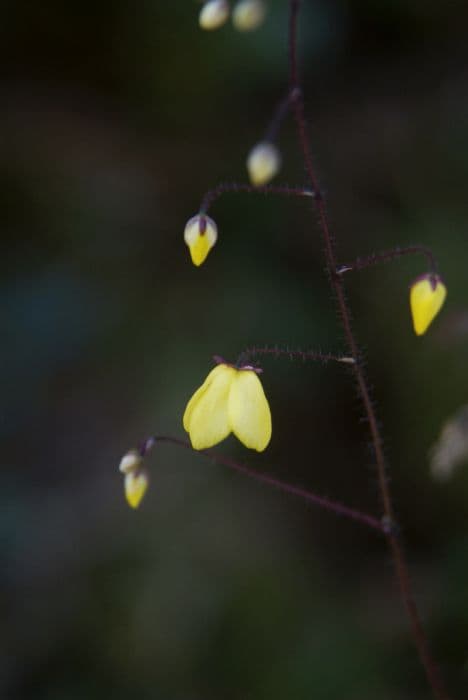
ABOUT
Epimedium ecalcaratum, commonly known as Epimedium or Fairy Wings, is a perennial plant that exhibits a unique and attractive appearance. The plant is characterized by its heart-shaped leaves that maintain interest throughout the season. During the spring, the foliage develops a bronze tint which typically transitions to green as the season progresses. Epimediums are particularly noted for their delicate, spidery flowers that add an ethereal charm to the plant's overall attractiveness. These blossoms can be found in a variety of hues including yellow, pink, white, or purple, each bringing a soft splash of color to the garden. The flowers are suspended on thin, wiry stems that dance above the foliage when stirred by a gentle breeze, suggesting the whimsical flight of fairies, hence one of its common names. Fairy Wings form a spreading ground cover that not only offers a horticultural appeal but also provides a visual softness and allure. Please note that the description avoids mentioning the specific dimensions of the plant.
About this plant
 Names
NamesFamily
Berberidaceae.
Synonyms
Spurless Epimedium, Spurless Horny Goat Weed, Epimedium.
Common names
Epimedium ecalcaratum.
 Toxicity
ToxicityTo humans
Epimedium, commonly known as horny goat weed, has not been widely reported to be toxic to humans when consumed in typical amounts often used in herbal supplements. However, as with any medicinal plant, it can have side effects or interactions with certain medications if taken inappropriately. It is always advisable to consult with a healthcare provider before starting any new herbal remedies, especially for individuals with pre-existing health conditions or who are taking other medications. Overconsumption could potentially lead to side effects, but specific symptoms of poisoning from Epimedium ecalcaratum are not well-documented in scientific literature. Always use herbal supplements responsibly and according to professional recommendations.
To pets
The horny goat weed (Epimedium) is not commonly listed as a toxic plant for pets, such as cats and dogs, but the specific toxicology of Epimedium ecalcaratum is not well-documented in veterinary literature. It is generally advised to prevent pets from ingesting plants not intended for them, as individual animals may have different sensitivities or reactions. If a pet ingests this plant and shows any signs of distress such as vomiting, diarrhea, or unusual behavior, it is important to seek veterinary attention.
 Characteristics
CharacteristicsLife cycle
Perennials
Foliage type
Deciduous
Color of leaves
Green
Flower color
Yellow
Height
1 feet (0.3 meters)
Spread
2 feet (0.6 meters)
Plant type
Herb
Hardiness zones
5
Native area
China
Benefits
 General Benefits
General Benefits- Ornamental Value: Epimedium ecalcaratum (Bishop's Hat) adds aesthetic appeal to gardens due to its delicate and attractive flowers.
- Shade Tolerance: It thrives well in partial or full shade, making it a suitable ground cover under trees or in shaded garden areas.
- Drought Resistance: Once established, the plant can tolerate periods of drought, requiring less frequent watering compared to other garden plants.
- Soil Adaptability: Bishop's Hat can adapt to a range of soil conditions, although it prefers well-drained, fertile soil.
- Erosion Control: Its ability to spread and form dense clumps makes it effective at preventing soil erosion in garden landscapes.
 Medical Properties
Medical Properties- Libido Enhancement: Epimedium, commonly known as Horny Goat Weed, contains icariin, which is thought to have properties that might help enhance sexual function.
- Osteoporosis Prevention: Some studies suggest that Epimedium might have effects on bone health, possibly helping to prevent bone loss.
- Cardiovascular Health: There is some evidence to suggest that the plant may have cardiovascular benefits, possibly improving circulation and heart health.
- Anti-inflammatory Effects: Components within Epimedium may possess anti-inflammatory properties which could be beneficial for reducing inflammation.
- Antioxidant Activity: The plant is believed to have antioxidant properties which can help in combating oxidative stress within the body.
 Air-purifying Qualities
Air-purifying QualitiesThis plant is not specifically known for air purifying qualities.
 Other Uses
Other Uses- Epimedium ecalcaratum, commonly known as horny goat weed, can be employed as a natural ground cover in shaded garden areas due to its dense foliage and ability to thrive in lower light conditions.
- In floristry, the sprays of Epimedium ecalcaratum are occasionally used in flower arrangements for their delicate and airy appearance, as well as their longevity once cut.
- This plant is often utilized in butterfly gardens as it provides nectar in early spring when few other plants are in bloom, subsequently attracting early butterflies and other pollinators.
- Landscape designers sometimes use Epimedium ecalcaratum for erosion control on slopes or in areas where grass struggles to grow, due to its spreading habit and robust root system.
- As a living mulch, the dense foliage of Epimedium ecalcaratum can suppress weeds by restricting the amount of sunlight reaching the ground, hence reducing the need for additional mulching materials.
- Some gardeners use this plant as a creative underplanting for taller, deciduous trees and shrubs to create a layered and textured garden aesthetic.
- Epimedium ecalcaratum is occasionally suggested for urban gardens where it can tolerate the challenge of reduced space and fluctuating environmental conditions common in city living.
- Dried leaves of horny goat weed can be incorporated into potpourris for a unique and slightly herbal fragrance note, although its scent is not commonly praised.
- In regions where deer browsing can be problematic for gardens, Epimedium ecalcaratum is a valuable addition due to its deer-resistant properties, as deer typically avoid eating it.
- Epimedium ecalcaratum can provide a subtle rustling sound when its leaves and stems are brushed by wind, creating an auditory component in garden design focusing on sensory experiences.
Interesting Facts
 Feng Shui
Feng ShuiThe Epimedium, commonly known as Horny Goat Weed, is not used in Feng Shui practice.
 Zodiac Sign Compitability
Zodiac Sign CompitabilityThe Epimedium, commonly known as Horny Goat Weed, is not used in astrology practice.
 Plant Symbolism
Plant Symbolism- Lust and Love: Epimedium, commonly known as Horny Goat Weed, has a longstanding association with desire and aphrodisiac properties, historically used to enhance libido and sexual performance.
- Vitality and Energy: This plant symbolizes rejuvenation and the restoring of energy, reflecting its use in traditional medicine to combat fatigue and improve overall vitality.
- Protection in Folklore: In some traditions, Epimedium is believed to offer protection against negative energies and to support spiritual health.
- Longevity: Due to its use in traditional medicine for promoting health and well-being, Horny Goat Weed has come to symbolize a long and healthy life.
- Youthfulness: The plant's reputed ability to increase vitality is often associated with maintaining a youthful state, both physically and mentally.
 Water
WaterBishop's hat should be watered regularly to maintain moist but not waterlogged soil, especially during its growing season in spring and early summer. Aim to provide about 1 inch of water weekly, increasing to 1.5 inches during particularly hot or dry periods. In established plants, reduce watering to when the top inch of soil feels dry to the touch, as this plant is somewhat drought tolerant once established. During winter months, cut back on watering to prevent root rot, providing just enough to keep the soil from drying out completely.
 Light
LightBishop's hat prefers partial to full shade, making it ideal for planting under trees or in shaded areas of the garden. It can tolerate a bit of morning sun, but should be shielded from intense afternoon rays to prevent leaf scorch. A spot that mimics the dappled sunlight of its natural woodland habitat is best for encouraging healthy growth.
 Temperature
TemperatureBishop's hat thrives in temperatures that mimic its native forest environments, generally maintaining a range of 50 to 75 degrees Fahrenheit. It can withstand a minimum temperature of about 5 degrees Fahrenheit, making it hardy in cooler climates. The ideal growing conditions, however, center around the cooler end of its temperature range, especially during the active growth phases in spring and fall.
 Pruning
PruningPrune Bishop's hat in late winter or early spring before new growth begins. This helps to remove any damaged or dead foliage and promotes healthier, more robust plants. Pruning is also an opportunity to shape the plant and control its spread if necessary. Typically, pruning once a year is sufficient, timed to clean up the plant after the harsher winter conditions.
 Cleaning
CleaningAs needed
 Soil
SoilFor the Epimedium, commonly known as Bishop's Hat, a well-draining soil mix with high organic content is ideal. It should be rich in compost or leaf mold, with a pH range between 5.5 and 7.5. A mix of one part garden soil, one part compost, and one part perlite or pine bark fines can create a suitable environment for this plant.
 Repotting
RepottingBishop's Hat should be repotted every 2 to 3 years or when it becomes root-bound. To ensure continued growth and health, repotting should be done in the spring before the growing season starts.
 Humidity & Misting
Humidity & MistingBishop's Hat thrives best in moderate to high humidity levels, ideally around 50% or higher. However, it is quite adaptable and can tolerate lower humidity environments if not too dry.
 Suitable locations
Suitable locationsIndoor
Provide bright, indirect light; water when the topsoil dries.
Outdoor
Plant in partial shade, protect from intense sun.
Hardiness zone
5-9 USDA
 Life cycle
Life cycleEpimedium ecalcaratum, commonly known as "Barrenwort", begins its life cycle as a seed, often dispersed by wind or animals, and upon finding suitable soil conditions, germinates typically in spring. The seedling emerges and develops into a juvenile plant with characteristic heart-shaped leaves and begins to establish a root system. As it matures, Barrenwort becomes a perennial herb with a robust rhizome that allows it to survive through varying seasons, and it enters a phase of vegetative growth where it expands its leaf and stem biomass. In spring, the plant produces delicate, spurred flowers that are usually pale yellow to white in color, attracting pollinators for sexual reproduction. Following pollination, seeds are produced and dispersed, completing the reproductive cycle. Barrenwort then enters a period of dormancy during colder months, with foliage often dying back, before rejuvenating and starting the cycle anew with the return of warmer weather.
 Propogation
PropogationPropogation time
Spring to early summer
For Epimedium ecalcaratum, commonly known as Bishop's Hat, the most popular method of propagation is by division. This is ideally performed in late summer or early fall, allowing the plant to establish before the onset of winter. To propagate Bishop's Hat through division, carefully lift the parent plant from the ground with a shovel, ensuring that you maintain a generous amount of soil around the roots. Gently tease apart the rhizomes or clumps, ensuring that each section has several growth points or buds. Replant the divisions immediately at the same soil depth they were growing previously, spacing them approximately 12 to 15 inches apart (about 30 to 38 centimeters). Water the newly transplanted divisions well to settle the soil around the roots and help reduce transplant shock. This method allows for the relatively fast expansion of your garden with new Epimedium ecalcaratum plants and helps rejuvenate older clumps that may have become too dense over time.
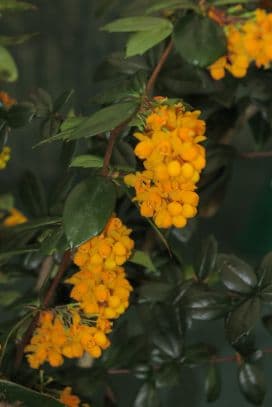
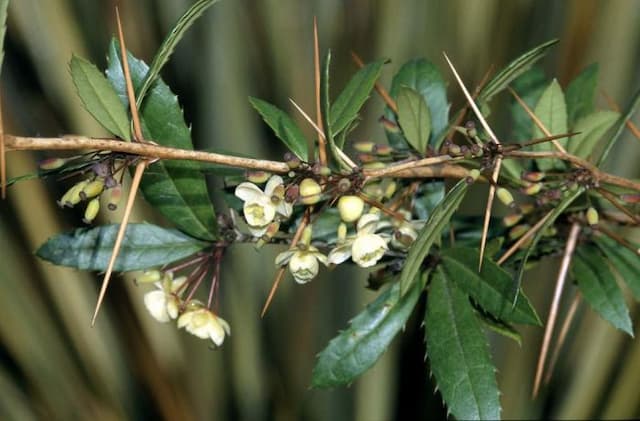
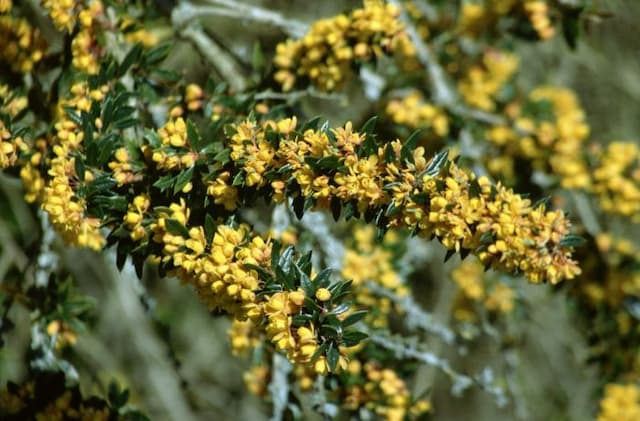
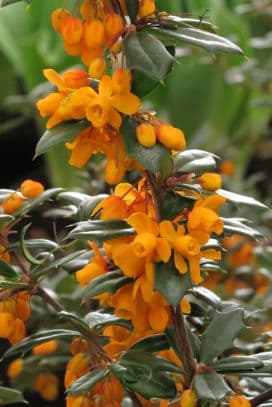



![Japanese barberry [Bonanza Gold]](/_next/image?url=https%3A%2F%2Fplants-admin.emdemapps.com%2Fimages%2Fplants%2F%2Fimages%2F604b5385e413f.png&w=640&q=75)

